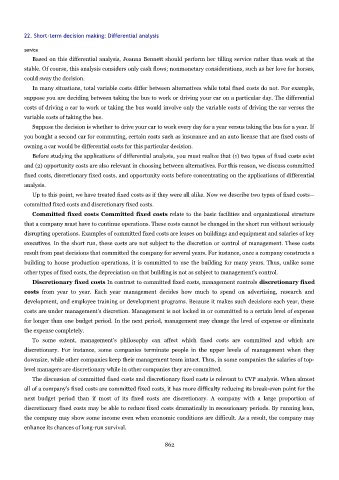Page 861 - Accounting Principles (A Business Perspective)
P. 861
22. Short-term decision making: Differential analysis
service
Based on this differential analysis, Joanna Bennett should perform her tilling service rather than work at the
stable. Of course, this analysis considers only cash flows; nonmonetary considerations, such as her love for horses,
could sway the decision.
In many situations, total variable costs differ between alternatives while total fixed costs do not. For example,
suppose you are deciding between taking the bus to work or driving your car on a particular day. The differential
costs of driving a car to work or taking the bus would involve only the variable costs of driving the car versus the
variable costs of taking the bus.
Suppose the decision is whether to drive your car to work every day for a year versus taking the bus for a year. If
you bought a second car for commuting, certain costs such as insurance and an auto license that are fixed costs of
owning a car would be differential costs for this particular decision.
Before studying the applications of differential analysis, you must realize that (1) two types of fixed costs exist
and (2) opportunity costs are also relevant in choosing between alternatives. For this reason, we discuss committed
fixed costs, discretionary fixed costs, and opportunity costs before concentrating on the applications of differential
analysis.
Up to this point, we have treated fixed costs as if they were all alike. Now we describe two types of fixed costs—
committed fixed costs and discretionary fixed costs.
Committed fixed costs Committed fixed costs relate to the basic facilities and organizational structure
that a company must have to continue operations. These costs cannot be changed in the short run without seriously
disrupting operations. Examples of committed fixed costs are leases on buildings and equipment and salaries of key
executives. In the short run, these costs are not subject to the discretion or control of management. These costs
result from past decisions that committed the company for several years. For instance, once a company constructs a
building to house production operations, it is committed to use the building for many years. Thus, unlike some
other types of fixed costs, the depreciation on that building is not as subject to management's control.
Discretionary fixed costs In contrast to committed fixed costs, management controls discretionary fixed
costs from year to year. Each year management decides how much to spend on advertising, research and
development, and employee training or development programs. Because it makes such decisions each year, these
costs are under management's discretion. Management is not locked in or committed to a certain level of expense
for longer than one budget period. In the next period, management may change the level of expense or eliminate
the expense completely.
To some extent, management's philosophy can affect which fixed costs are committed and which are
discretionary. For instance, some companies terminate people in the upper levels of management when they
downsize, while other companies keep their management team intact. Thus, in some companies the salaries of top-
level managers are discretionary while in other companies they are committed.
The discussion of committed fixed costs and discretionary fixed costs is relevant to CVP analysis. When almost
all of a company's fixed costs are committed fixed costs, it has more difficulty reducing its break-even point for the
next budget period than if most of its fixed costs are discretionary. A company with a large proportion of
discretionary fixed costs may be able to reduce fixed costs dramatically in recessionary periods. By running lean,
the company may show some income even when economic conditions are difficult. As a result, the company may
enhance its chances of long-run survival.
862

